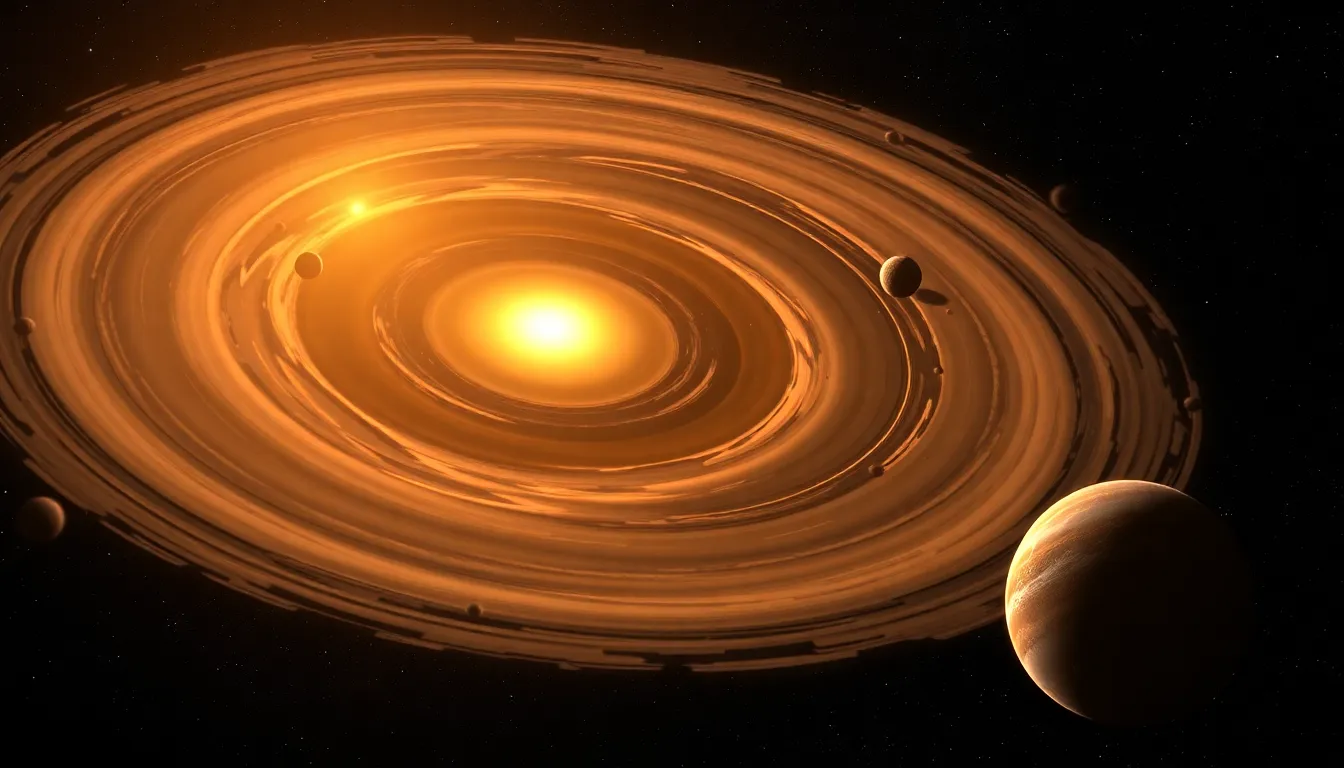Table of Contents
ToggleIn the vast cosmic dance of the universe, planetary systems are the dazzling ballrooms where celestial bodies waltz around their stars. Picture this: a swirling collection of planets, moons, asteroids, and comets, all bound together by gravity and a sprinkle of cosmic magic. It’s like a galactic family reunion, only with fewer awkward conversations and a lot more space dust.
Understanding these planetary systems isn’t just for stargazers and science nerds; it’s crucial for unraveling the mysteries of our own solar system and beyond. From gas giants to rocky worlds, each system offers a unique glimpse into the forces that shape our universe. So buckle up as we embark on a journey through the stars, exploring the wonders of planetary systems that might just make you rethink your next vacation destination—who wouldn’t want to visit a planet with rings?
Overview of Planetary Systems
Planetary systems comprise various celestial bodies, including planets, moons, asteroids, and comets. These bodies revolve around stars, influenced by gravitational forces. Each planetary system exhibits unique characteristics, making them diverse and intriguing.
The solar system serves as a prime example, containing eight planets, numerous moons, and other small celestial objects. Mercury, Venus, Earth, and Mars represent terrestrial planets, while Jupiter, Saturn, Uranus, and Neptune classify as gas giants. Patterns emerge in their orbits and formations, reflecting different evolutionary paths.
Beyond our solar system lies a plethora of exoplanetary systems. These systems contain planets outside the Earth’s orbit. Some exoplanets are Earth-like, located in the habitable zone, while others present extreme environments, such as gas giants with no solid surface. Information gathered from observations has expanded understanding of potential habitability.
Certain planetary systems feature fascinating elements, such as rings or unusual orbital alignments. The ringed giants, like Saturn, capture interest with their stunning displays. Unconventional orbits, including those of hot Jupiters, challenge existing theories about planet formation.
The study of planetary systems enhances knowledge of cosmic processes. Research efforts probe how systems form, evolve, and interact in the universe. Observational tools, such as the Hubble Space Telescope and the Kepler Space Telescope, deliver crucial data. These findings may one day unlock secrets of planetary climates and potential life.
Planetary systems continuously evolve and reveal new wonders. Each discovery contributes to a broader understanding of the universe and its complexities. Scientists remain committed to exploring these celestial environments for insights about our place in the cosmos.
Formation of Planetary Systems

Planetary systems form through mechanisms rooted in astrophysical processes. These systems evolve alongside stars, shaping their unique characteristics and structures.
Nebular Hypothesis
The nebular hypothesis explains the formation of planetary systems as a result of a rotating cloud of gas and dust, known as a solar nebula. This cloud collapses under its own gravity, leading to the creation of a protostar at its center. From the surrounding material, solid particles coalesce to form planetesimals. These planetesimals continue to collide and merge, eventually creating planets. New observations support this hypothesis, showcasing disks of material around young stars, which offer evidence of ongoing planet formation.
Gravitational Interactions
Gravitational interactions play a crucial role in shaping planetary systems. These interactions occur when celestial bodies exert influence over each other, affecting their orbits and structures. In a planetary system, larger bodies tend to dominate smaller ones, leading to the clearing of debris in their orbits. This process contributes to the formation of stable, well-defined orbits for planets and moons. Dynamic interactions can also disrupt orbits, resulting in phenomena such as planet migration and the capture of wandering bodies. Enhanced understanding of these interactions aids researchers in explaining the diversity seen in exoplanetary systems.
Types of Planetary Systems
Planetary systems manifest in various configurations, primarily categorized by the number of stars they contain. Understanding these types enhances knowledge of celestial dynamics and the environments in which planets reside.
Single Star Systems
Single star systems revolve around one central star. The majority of planetary systems fall into this category, including our own solar system. Characteristics of these systems typically feature planets, moons, and other celestial bodies governed by the star’s gravitational pull. Examples include the nearby star Alpha Centauri A, hosting at least one confirmed exoplanet. Various factors, such as distance from the star and its energy output, significantly influence the planets’ atmospheres and potential for life.
Multiple Star Systems
Multiple star systems consist of two or more stars. These systems create complex gravitational dynamics that affect the orbits of their planets. Systems like Alpha Centauri are notable examples, featuring three stars, while others, like binary systems, consist of just two stars. Planets in these systems may exhibit unusual orbital patterns due to the varying gravitational forces from multiple stars. Various studies suggest that some planets can maintain stable orbits despite these complexities, expanding the possibilities for habitability within such unique configurations.
Exoplanets and Their Discoveries
Exoplanets represent a fascinating area of study within planetary systems. These celestial bodies orbit stars outside our solar system, with numerous detection methods aiding in their discovery.
Detection Methods
Astronomers utilize various techniques to identify exoplanets. The transit method observes a star’s brightness dip when a planet crosses in front of it, enabling the estimation of the planet’s size and orbit. Radial velocity measures shifts in a star’s spectrum due to gravitational tugs from orbiting planets. Direct imaging captures light from the planets, revealing their atmospheres and characteristics. Gravitational microlensing relies on the bending of light from distant stars, sparking additional insights into planetary masses. Each technique enhances the understanding of diverse exoplanetary environments.
Notable Exoplanets
Several exoplanets stand out due to their unique features and discovery significance. Proxima Centauri b, the closest known exoplanet, resides in the habitable zone of Proxima Centauri, hinting at potential habitability. TRAPPIST-1 hosts seven Earth-sized planets, three within the habitable zone, sparking excitement about their potential for life. HD 209458 b, nicknamed “Osiris,” represents the first exoplanet observed transiting its star, providing insights into atmospheres and planetary composition. Kepler-186f, a roughly Earth-sized exoplanet, orbits within the habitable zone of its star, showcasing the diversity of exoplanet candidates. These examples underscore the ongoing exploration and discovery in exoplanet research.
The Future of Planetary Systems Research
The future of planetary systems research promises exciting discoveries and deeper insights into the cosmos. Scientists continuously explore new frontiers with upcoming missions and technological advancements.
Upcoming Missions
Various space missions scheduled for the next decade aim to enhance knowledge of planetary systems. The James Webb Space Telescope, launching in December 2021, provides unprecedented detailed observations of distant exoplanets. Meanwhile, NASA’s Europa Clipper mission aims to study Jupiter’s moon Europa, which may harbor a subsurface ocean. ESA’s ARIEL mission, launching in 2029, will focus on characterizing atmospheres of exoplanets. Missions like these significantly contribute to understanding planetary formation and habitability.
Technological Advancements
Advancements in technology reshape the landscape of planetary systems research. Improved telescopes, such as the European Extremely Large Telescope, enhance the ability to detect smaller planets and analyze atmospheric compositions. Artificial intelligence tools increasingly assist in processing vast datasets, identifying patterns in exoplanet characteristics. Additionally, spectroscopic techniques allow for detailed composition analysis of exoplanet atmospheres. These innovations drive researchers to refine models of planetary formation and explore the potential for life beyond Earth.
The exploration of planetary systems reveals the intricate dance of celestial bodies influenced by gravitational forces. As researchers uncover the mysteries of these systems they not only deepen their understanding of our solar system but also expand the horizons of what’s possible in the universe. The ongoing advancements in technology and observational methods promise to unveil even more about the nature of planets and their potential for supporting life.
With each new discovery the allure of planetary systems grows stronger. The future holds exciting prospects for both science and exploration as humanity continues to reach for the stars. The quest to understand these cosmic environments is just beginning and it invites everyone to share in the wonder of the universe.





